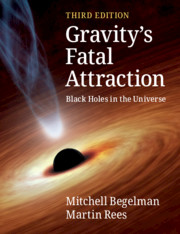Refine search
Actions for selected content:
3430 results in Popular science
Frontmatter
-
- Book:
- Gravity's Fatal Attraction
- Published online:
- 29 September 2020
- Print publication:
- 05 November 2020, pp i-iv
-
- Chapter
- Export citation
3 - Black Holes in Our Backyard
-
- Book:
- Gravity's Fatal Attraction
- Published online:
- 29 September 2020
- Print publication:
- 05 November 2020, pp 51-72
-
- Chapter
- Export citation
4 - Galaxies and Their Nuclei
-
- Book:
- Gravity's Fatal Attraction
- Published online:
- 29 September 2020
- Print publication:
- 05 November 2020, pp 73-108
-
- Chapter
- Export citation
12 - Through the Horizon
-
- Book:
- Gravity's Fatal Attraction
- Published online:
- 29 September 2020
- Print publication:
- 05 November 2020, pp 269-292
-
- Chapter
- Export citation
5 - Quasars and Kin
-
- Book:
- Gravity's Fatal Attraction
- Published online:
- 29 September 2020
- Print publication:
- 05 November 2020, pp 109-130
-
- Chapter
- Export citation
Further Reading
-
- Book:
- Gravity's Fatal Attraction
- Published online:
- 29 September 2020
- Print publication:
- 05 November 2020, pp 297-298
-
- Chapter
- Export citation
11 - GravitationalWaves
-
- Book:
- Gravity's Fatal Attraction
- Published online:
- 29 September 2020
- Print publication:
- 05 November 2020, pp 249-268
-
- Chapter
- Export citation
Figure Credits
-
- Book:
- Gravity's Fatal Attraction
- Published online:
- 29 September 2020
- Print publication:
- 05 November 2020, pp 299-308
-
- Chapter
- Export citation
Contents
-
- Book:
- Gravity's Fatal Attraction
- Published online:
- 29 September 2020
- Print publication:
- 05 November 2020, pp v-vi
-
- Chapter
- Export citation
Preface
-
- Book:
- Gravity's Fatal Attraction
- Published online:
- 29 September 2020
- Print publication:
- 05 November 2020, pp vii-x
-
- Chapter
- Export citation
Index
-
- Book:
- Gravity's Fatal Attraction
- Published online:
- 29 September 2020
- Print publication:
- 05 November 2020, pp 309-322
-
- Chapter
- Export citation
10 - Postcards from the Edge
-
- Book:
- Gravity's Fatal Attraction
- Published online:
- 29 September 2020
- Print publication:
- 05 November 2020, pp 233-248
-
- Chapter
- Export citation

Gravity's Fatal Attraction
- Black Holes in the Universe
-
- Published online:
- 29 September 2020
- Print publication:
- 05 November 2020
-
- Textbook
- Export citation
4 - Refugees and Migration
-
-
- Book:
- Migration
- Published online:
- 25 March 2020
- Print publication:
- 04 June 2020, pp 79-95
-
- Chapter
- Export citation
3 - Art and Migration
-
-
- Book:
- Migration
- Published online:
- 25 March 2020
- Print publication:
- 04 June 2020, pp 50-78
-
- Chapter
- Export citation
7 - Migration in Science
-
-
- Book:
- Migration
- Published online:
- 25 March 2020
- Print publication:
- 04 June 2020, pp 148-165
-
- Chapter
- Export citation
Index
-
- Book:
- Migration
- Published online:
- 25 March 2020
- Print publication:
- 04 June 2020, pp 181-184
-
- Chapter
- Export citation
1 - Black and British Migration
-
-
- Book:
- Migration
- Published online:
- 25 March 2020
- Print publication:
- 04 June 2020, pp 5-17
-
- Chapter
- Export citation
6 - The Partition of India and Migration
-
-
- Book:
- Migration
- Published online:
- 25 March 2020
- Print publication:
- 04 June 2020, pp 131-147
-
- Chapter
- Export citation
Figures
-
- Book:
- Migration
- Published online:
- 25 March 2020
- Print publication:
- 04 June 2020, pp viii-ix
-
- Chapter
- Export citation
